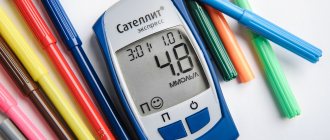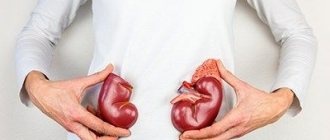General information
In many cases, diabetes is a natural consequence of increased consumption of carbohydrates that are easily accessible to the body. An abundance of sweets against the backdrop of regular overeating and lack of physical activity is especially dangerous, which allows us to call this disease “the scourge of developed civilizations.”
Statistics! Officially, there are more than 250 million people with diabetes in the world, of which more than 8 million people (6% of the population) live in Russia. However, given that the early stages of type 2 diabetes are almost devoid of symptoms, the actual number of patients may reach 400 million people. Representatives of the Mongoloid and Negroid races are most susceptible to pathology, while the frequency of occurrence among Caucasians is much lower. This may be due to both the biochemistry and the nutritional habits of different racial groups.
Treatment
Treatment of diabetes is all about managing the disease throughout your life. Type 1 diabetes involves constant administration of the missing hormone to the patient - insulin. In addition, adherence to diet, proper distribution of physical activity and self-discipline play an important role in treatment.
Drug treatment: insulin therapy
People with type 1 diabetes need insulin injections every day to control blood sugar levels and get the energy the body needs. The doctor, together with the patient, selects the most effective type and regimen of drug administration.
Entering a fixed dose of insulin
When choosing this regimen, the patient injects himself with a fixed dose of insulin throughout the day. In this case, you need to carefully monitor the amount of carbohydrates consumed and take into account physical activity so as not to cause a state of hyper- or hypoglycemia.
Basal-bolus regimen
This scheme simulates the production of insulin by the pancreas. Following this, the patient injects himself with long-acting basal insulin to maintain blood sugar levels in the absence of food. Before meals, to eliminate sugar surges, a bolus of short-acting insulin is also administered.
Its dose depends on the blood sugar level and the amount of carbohydrates in the dishes consumed. This is a more flexible scheme in terms of power mode. The main thing is to correctly measure how much insulin you need.
Important! Your attending physician and specialists from the School of Diabetes will teach you how to dose insulin depending on the calorie content of food and physical activity. Check her address at your local clinic. Muscovites can find him out at this link. It is advisable to take classes at such a school annually. You will have to carefully analyze everything you eat, calculate how many units of insulin you need to inject for this, and monitor how the body reacts to the injection.
How to administer insulin
There is no need to be afraid of insulin therapy. For convenient administration of insulin, easy-to-use devices have long been developed: an insulin pump and a “penfill” - a syringe pen with insulin.
Insulin pump
The insulin pump (Fig. 2) independently administers the required amount of insulin throughout the day, imitating the work of the pancreas. In this case, short-acting insulin is used; the insulin bolus program before meals can be adjusted depending on dietary habits.
Figure 2. Insulin pump. Source: Alan Levine/Flickr.
Pump insulin therapy has a number of contraindications, including the presence of a mental illness that can lead to improper use of the device, decreased vision (if this interferes with interaction with the interface), acute somatic (non-mental) diseases or exacerbations of chronic diseases, psycho-emotional stress.
In addition, the use of a pump is not recommended for newly diagnosed type 1 diabetes mellitus, but this is a temporary limitation due to the fact that the patient must first learn to count insulin, and only then proceed to pump therapy.
Penfill
Penfill (Fig. 3) is a syringe pen for administering insulin. The pen allows you to change the insulin dose using a selector.
Figure 3. Penfill. Source: CC0 Public Domain
Important! The dose of insulin administered should correspond as closely as possible to the amount of carbohydrates consumed. When using a pen, never inject excess insulin “just in case”! A drop in blood glucose levels (hypoglycemia) occurs very quickly and you may lose consciousness.
Sugar control
Since the dose of insulin depends on the level of sugar in the blood, it must be constantly measured using a glucometer (Fig. 4).
Figure 4. Glucometer for measuring blood sugar. Source: Amanda Mills/USCDCP/Pixnio
Ask your doctor what your goal sugar level should be and how often you should check it. Staying as close to your target as possible will help you prevent or delay diabetes-related complications.
Diabetes while traveling
Before traveling, visit your doctor for advice about your itinerary, planned physical activity, and possible changes in insulin dosage and regimen.
Bring with you the necessary amount of insulin or prescriptions to purchase it. Check to see if your drug is available where you are going. Stock up on test strips for your glucose meter: changing your diet can lead to fluctuations in glycemia. It is better to take with you 2 times more medications than you usually need.
Get a medical bracelet that indicates you have diabetes. Get travel insurance in case you miss your flight or need medical attention. Order a special meal on board or take food on the go.
Your continuous glucose meter and insulin pump may turn off during airport X-ray screening. Ask customs officials for a manual inspection.
Diet
Dietary restrictions for patients with type 1 diabetes are relevant if the dose of insulin administered is fixed. This primarily concerns carbohydrates. Their excess or deficiency can provoke surges in blood glucose.
If the dose of insulin is calculated every time before meals, you will not have to limit yourself in food. You just need to take into account how a particular product affects blood sugar levels by calculating its glycemic index (GI), and how much “short” insulin is needed to control carbohydrate metabolism after a particular food.
“A patient with type 1 diabetes can eat anything, provided that the dose of insulin is calculated correctly,” says Professor L. Yu. Morgunov.
However, the diet for type 1 diabetes should be balanced and based on the principles of healthy eating. Pay special attention to the ratio of carbohydrates, fats and proteins: the amount of insulin you need directly depends on this.
For diabetes, doctors advise reducing consumption:
- salted, smoked, pickled dishes,
- foods high in starch and fat,
- confectionery products, sauces and semi-finished products.
Drink less fruit juices, sugary drinks and fast food - these are also harmful for a healthy person.
Physiotherapy
If you regularly engage in sports or fitness, alternating strength training with cardio exercise, remember the existence of a “carbohydrate window”. Due to inexperience, you can end up in a situation of life-threatening hypoglycemia. Therefore, be sure to inform your trainer about your diagnosis and do not practice alone at first. Avoid injecting insulin before exercise to avoid causing your blood sugar to drop. Calculate with your doctor how much you need to reduce your usual insulin dose on training days.
Important! Patients with diabetes, like healthy people, benefit from feasible physical activity - walking, jogging, children - outdoor games. In the early stages of using insulin, avoid prolonged active swimming, mountain climbing, fast or strenuous cycling: an acute drop in blood sugar (due to the administration of too much insulin for such an intense activity) with weakness to the point of fainting can lead to injury and pose a threat to life.
Causes and mechanism of development
In medicine, there is no consensus on what causes diabetes mellitus, so it is classified as a multifactorial disease, where poor heredity and risk factors are of great importance.
The following factors can play the role of a “trigger”:
- poor diet with an abundance of easily accessible carbohydrates and refined foods;
- overweight with a mass index of more than 30 and abdominal fat deposits;
- chronic disturbance of water balance in the body;
- previous endocrine pathologies - diffuse goiter, Itsenko-Cushing syndrome;
- constant stress;
- infectious diseases with complications - the so-called “childhood diseases” (measles, rubella) are especially dangerous;
- injuries and chronic diseases of the pancreas (pancreatitis, gland calcification, cysts, vascular sclerosis, etc.).
Attention! A high risk of congenital diabetes is typical for children born with a large body weight - 4 kg or more. In this case, the child is registered with an endocrinologist from birth with regular monitoring of his condition as he grows up.
The development of the disease is closely related to insulin and the body’s response to it. The hormone is the main participant in carbohydrate metabolism, namely, it is responsible for the absorption of glucose. This simple sugar is called a universal source of energy for the whole body. At the same time, some organs require the presence of insulin to absorb it and are insulin-dependent (liver), others are able to do this directly, and therefore are called insulin-independent (brain).
After eating, your blood sugar levels naturally rise. To bring it back to normal, the body gives the command to produce insulin, which helps the body absorb glucose and store its excess “in reserve” in the liver (in the form of glycogen), muscles and adipose tissue. In diabetes, this sequence of actions fails, and events can develop in two ways:
- Insulin production decreases to a critical level or stops completely.
- The body produces insulin in sufficient quantities, but cells and organs become resistant to this hormone and simply do not notice it.
As a result, cells and organs experience energy starvation, and almost all sugar continues to circulate in the blood without undergoing metabolic transformation, which provokes the phenomenon of hyperglycemia.
On a note! Insulin's function is not limited to maintaining glucose levels.
Additionally, the hormone is involved in the synthesis of fatty acids, which makes it a simultaneous participant in lipid metabolism. This fact confirms the deep interconnection of metabolism in the body and explains the frequent complication of diabetes by vascular atherosclerosis.
Causes of type 1 diabetes in children and adolescents
Many parents are mistaken in thinking that diabetics got sick because they ate a lot of chocolate and sugar. If you limit your child’s sweets, he can be protected from diathesis rather than from diabetes. Children get diabetes at an early age not because of poor diet. This is evidenced by the findings of scientists studying this problem.
The authoritative scientist Andreas Beyerlein from the Munich Helmholtz Center conducted a study, upon completion of which the following conclusions were made:
- A severe viral infection suffered at the age of 0-3 years leads to the development of type 1 diabetes mellitus in 84%, and the pathology is more often diagnosed when the child reaches the age of 8.
- Acute acute respiratory viral infection suffered by infants under 3 months causes diabetes in 97% of cases.
- In children with a hereditary predisposition to hyperglycemia, the risk of developing the disease increases depending on nutritional factors (nutrition): artificial feeding, early consumption of cow's milk, high birth weight (above 4.5 kg).
There are two peak ages for detecting diabetes in children - 5-8 years and adolescence (13-16 years). Unlike adults, childhood diabetes develops very quickly and rapidly. The disease manifests itself as an acute form of ketoacidosis (poisoning by ketone bodies formed in the liver) or diabetic coma.
As for heredity, the likelihood of transmitting T1DM is low. If the father has type 1 diabetes, the risk of transmission to children is 10%. If the mother, then the risks are reduced to 10%, and in late births (after 25 years) to 1%.
Identical twins have different risks of getting the disease. If one child is sick, the disease occurs in the second no more than 30-50%.
Diabetes classification
Diabetes mellitus has 2 main types, which differ fundamentally in the etiology of the pathological process and in the initial stages require a different approach to treatment:
- Type 1 insulin-dependent diabetes develops in response to the body's autoimmune aggression against the beta cells of the pancreas that produce insulin. As a result, the level of the hormone decreases pathologically, which threatens high rates of hyperglycemia. Typical for children and young people. In older people, it manifests itself as a consequence of pancreatic necrosis with complicated pancreatitis. Requires hormone replacement therapy with insulin.
- Non-insulin-dependent diabetes type 2 develops in the form of increased body resistance to insulin while maintaining the working function of the pancreas. Typical for people over 40 years of age. In the early stages, it can be corrected without hormonal treatment with the help of diet.
On a note! The term “insulin-independent” in relation to type 2 diabetes remains true as long as it is possible to restore the sensitivity of target cells to insulin. In severe cases, when increased hormone synthesis prematurely depletes the pancreas, it is necessary, as in the case of type 1 diabetes, to resort to insulin therapy.
In addition to the 2 main groups, there are so-called situational and specific types of diabetes:
- gestational – a reversible pathology characteristic of a difficult pregnancy;
- pancreatogenic – occurs as a secondary injury against the background of primary injuries and diseases of the pancreas;
- LADA diabetes (latent autoimmune diabetes) – characterized by sluggish symptoms, but requires injection treatment with insulin;
- MODY diabetes is a genetic form of diabetes.
How does type 1 diabetes develop?
What is the trigger for the development of type 1 diabetes, like all autoimmune diseases, there is still no exact answer. But the main cause of the disease is known - a lack of insulin occurs due to the death of cells in the islets of Langerhans. The islets of Langerhans are areas on the tail of the pancreas that produce endocrine cells that participate in various life processes.
The role of endocrine cells is extensive, to be convinced of this, it is enough to consider a few examples:
- Alpha cells produce glycogen, which stores energy in the liver. This polysaccharide is the main form of glucose storage: glycogen reserves in the liver in a healthy person can reach 6% of the total body weight. Glycogen from the liver is available to all organs and can quickly replenish glucose deficiency in the body.
- Beta cells produce insulin, which converts glucose from the blood into energy. If the number of beta cells is insufficient or their work is poor, there is not enough insulin, so glucose remains unchanged in the blood.
- Delta cells are responsible for the production of somatostatin, which is involved in the functioning of the glands. Somatostatin limits the secretion of somatotropin - growth hormone.
- PP cells stimulate the production of gastric juice, without which complete digestion of food is impossible.
- Epsilon cells secrete a secretion that stimulates appetite.
The islets of Langerhans are equipped with capillaries, innervated by the vagus and peripheral nerves, and have a mosaic structure. The islets that produce certain cells are interconnected. Beta cells that produce insulin inhibit the production of glucogen. Alpha cells suppress the production of beta cells. Both islets reduce the amount of somatostatin produced.
Failure of immune mechanisms leads to the body's immune cells attacking the cells of the islets of Langerhans. Due to the fact that 80% of the surface of the islets is occupied by beta cells, they are the ones that are destroyed the most.
Dead cells cannot be restored; the remaining cells produce too little insulin. It is not enough to process the glucose entering the body. All that remains is to take insulin artificially in the form of injections. Diabetes mellitus becomes a lifelong death sentence; it cannot be cured and leads to the development of concomitant diseases.
Diabetes mellitus: symptoms of the disease
In the early stages, symptoms of diabetes may be mild, absent altogether, or mixed with symptoms of other pathologies, which requires differential diagnosis. However, there are a number of signs that should be treated with special attention. Among them:
- dry mouth with normal water intake;
- frequent urge to urinate;
- dry and itchy skin on the palms, elbows, feet;
- constant feeling of hunger;
- rapid weight gain;
- slow wound healing;
- increased sweating;
- constant feeling of fatigue, low performance,
Where type 1 diabetes is diagnosed and treated in St. Petersburg, prices
If you suspect diabetes, be sure to get tested; this can be done at the Diana Clinic in St. Petersburg. Here you can get advice from an experienced endocrinologist, undergo expert ultrasound of the pancreas and other types of diagnostics. The cost of an ultrasound is 1000 rubles, the cost of an appointment with an endocrinologist is 1000 rubles.
If you find an error, please select a piece of text and press Ctrl+Enter
Complicated course of the disease
The prolonged absence of therapeutic measures adds signs of complications to the main symptoms:
- a sharp decline in vision and disturbances in the structure of the eyeball;
- increased blood pressure;
- lipid metabolism disorders with vascular atherosclerosis;
- headache;
- severe swelling of tissues;
- smell of acetone in urine;
- neurological pain in the heart area;
- decreased sensitivity in hands and feet.
On a note! In advanced cases of acidosis (acidification of the body), patients develop lactic acidotic coma, which can lead to serious consequences, including death. Urgent hospitalization to restore the acid-base balance is the only possible solution. In a hospital setting, hemodialysis, artificial hyperventilation and forced alkalization of the body with small doses of sodium bicarbonate are performed.
What are the dangers of diabetes
Against the background of constantly high blood sugar or the so-called “swing” (alternating hyper- and hypoglycemia), the brain, which runs on pure glucose, suffers, and other organs, led by the heart and kidneys, fail. A person with diabetes can die because their blood glucose levels are too high or too low.
By affecting blood vessels and nerve endings, diabetes can lead to loss of vision, including blindness, and diabetic foot with non-healing ulcers, subsequent development of gangrene and amputation.
Diagnostics
The main clinical manifestation of diabetes is hyperglycemia, or high blood sugar, so the main way to diagnose diabetes is a blood glucose test. Normally, the level should be no higher than 6.1 mmol/l on an empty stomach and no more than 11 mmol/l 2 hours after a meal. It should be remembered that a single blood test for glucose will not give an objective result. To determine the current condition, make a diagnosis and prescribe treatment, they carry out.
- glucose tolerance test;
- blood chemistry;
- blood test for electrolytes;
- Rehberg test - to assess the condition of the kidneys;
- fundus examination;
- analysis of endogenous insulin levels;
- vascular examination - ultrasound, rheovasography, capillaroscopy, etc.;
- Ultrasound of organs, ECG.
Exercise for diabetes
Physical activity for type 1 diabetes is simply necessary, although there are restrictions regarding the type of sport. Exercise normalizes blood pressure, improves well-being, and normalizes weight. But in some cases, physical activity causes spikes in blood glucose levels.
If you have type 1 diabetes, you cannot overload yourself, so training should not exceed 40 minutes a day. The following sports are acceptable:
- walking, cycling;
- swimming, aerobics, yoga;
- table tennis, football;
- exercises in the gym.
Any exercise is contraindicated if ketones, protein breakdown products, are found in the urine, and if blood pressure has increased or problems with blood vessels have appeared.
How is the treatment carried out?
Main directions of treatment measures:
- stabilization and normalization of vital signs;
- drug compensation of carbohydrate metabolism;
- treatment of complications (if any);
- adaptation of the patient to a special lifestyle (diet, physical activity, maintaining fluid balance, insulin injections and/or taking non-hormonal medications, etc.).
Attention! Treatment for diabetes mellitus lasts for months and requires strict adherence to all prescriptions. A complete cure for insulin-dependent diabetes is considered impossible, but with a high level of self-control, the quality of life can be significantly improved.
Drug therapy:
- Injections of the hormone insulin are used as mandatory hormone replacement therapy for type 1 diabetes, as well as in severe cases of insulin resistance to the endogenous hormone, when classical treatment methods do not bring results.
- Antihyperglycemic drugs are used as an adjuvant in the treatment of non-insulin-dependent diabetes to increase the production of its own hormone and accelerate the utilization of glucose by tissues (primarily muscle).
- Drugs from the statin group are used to lower blood cholesterol levels.
- Medicines to maintain normal blood pressure (mainly ACE inhibitors - powerful, but quite mild in terms of various “side effects”).
Transplantation may be used as an alternative treatment for type 1 diabetes. They use both transplantation of the entire gland and its individual sections - the islets of Langerhans, responsible for the production of insulin. The main approach to treating type 2 diabetes is diet therapy. It is also an excellent measure for the prevention of metabolic disorders.
Late chronic types of complications of diabetes mellitus
Diabetic micro- and macroangiopathy
Damage to the walls of large vessels and capillaries, accompanied by a violation of the functional state of the blood.
Causes
Occurs during decompensation of diabetes - with large daily fluctuations in the levels of glucose, proteins and fats. Aggravating factors of development are obesity, hypertension, smoking.
Signs
Due to metabolic disorders, the vessels of target organs are affected - the heart and limbs, the retina and the renal glomeruli. Because of this, the supply of oxygen to tissues is reduced, hormonal balance and metabolic processes are disrupted.
As a result:
- visual functions deteriorate;
- cardiovascular and renal failure develops;
- brain activity and nerve conduction are disrupted;
- Trophic ulcers develop on the arms and legs.
Without treatment, angiopathy progresses and can lead to complete blindness, amputations of limbs, heart attacks and intoxications, and deterioration of mental abilities.
Treatment
Diabetic angiopathy requires correction of the treatment regimen, as well as normalization of weight and blood pressure, and cessation of smoking. In addition, the doctor may prescribe drugs that strengthen the vascular wall - flavonoids, venotonics and phlebotonics.
Diabetic polyneuropathy
Damage to nerve endings up to complete ischemia - loss of sensitivity in the affected areas.
Causes
Develops with elevated blood sugar levels - when the drug or dose is chosen incorrectly.
Signs
Manifested by pain, loss of sensitivity, numbness, and night cramps. If large nerve fibers are damaged, loss of balance may occur.
Treatment
The goal of treatment is compensation of diabetes mellitus. Also indicated are drugs that improve neuromuscular conduction and symptomatic drugs for pain and cramps.
Diabetic encephalopathy
Damage to brain structures - mainly neurons and white matter. It develops slowly and imperceptibly, so it often appears in the later stages.
Causes
Typical metabolic disorders associated with long-term diabetes mellitus. In addition, risk factors are atherosclerosis, hypertension, and increased levels of C-peptide in the blood.
Signs
- deterioration of mental activity – mild to moderate (dementia rarely develops);
- emotional instability;
- increased anxiety;
- tendency to depression;
- chronic fatigue syndrome.
Treatment
Regular cognitive screenings and maintaining normal blood sugar levels. To improve brain activity, nootropic, antioxidant, antiplatelet and vasoactive drugs, vitamins B, E and alpha-lipoic acid are prescribed.
Diabetic foot syndrome
Purulent-necrotic and ulcerative lesions of the feet.
Causes
The condition occurs due to complex changes against the background of diabetic pathologies of blood vessels, nerves and tissues.
Signs
It manifests itself as increased trauma and infection of tissues, purulent-necrotic processes, which may require amputation.
Treatment
- control and correction of blood glucose levels;
- control and correction of blood pressure and cholesterol levels;
- professional foot care, monthly examinations by a podiatrist;
- unloading the foot;
- antiseptics and antibiotics for signs of wound infection;
- painkillers;
- drugs that improve nerve conduction;
- medications that improve blood flow.
When phlegmons and abscesses form, surgical opening is indicated. According to indications, angioplasty and stenting are performed. In extreme cases, gentle resections or amputations may be necessary.
Diabetic nephropathy
Damage to kidney structures due to diabetic metabolic disorders.
Causes
Elevated blood sugar levels cause increased pressure in the glomeruli. Because of this, the kidneys begin to excrete protein in the urine. Over time, this causes fibrosis of the kidney tissue. A factor that worsens the prognosis is concomitant atherosclerosis.
Signs
The disease remains asymptomatic for years and eventually leads to kidney failure. Its symptoms are a sharp decrease in daily urine volume and critical disruption of urinary processes.
Treatment
Selecting the correct treatment regimen allows you to prevent the process and even cause its reverse development in the early stages of the disease. Specific treatment is carried out with ACE inhibitors or angiotensin receptor blockers. Nephroprotectors are often prescribed; in severe cases - hemodialysis.
For elevated cholesterol levels, statins are indicated, and for hypertension, antihypertensive drugs are indicated. Diabetics with nephropathy are prescribed a diet with moderate restriction of animal protein. It is also important to normalize your weight and quit smoking.
Diabetic retinopathy
Damage to the vessels of the retina of the eyeballs.
Causes
Develops due to decompensation of diabetes. Due to increased blood glucose levels, the barrier properties of the retinal tissues decrease, the lumen of the vessels and the blood flow in them increase, the inner wall of the vessels is damaged, and the capillaries become permeable. Due to repeated hemorrhages, degeneration of the ocular structures develops.
Signs
Diabetic retinopathy is manifested by deterioration of vision up to complete blindness. Possible eye pain.
Treatment
Annual examination by an ophthalmologist specializing in diabetes, monitoring of sugar levels and dietary therapy. Animal fats are replaced with vegetable fats, fast carbohydrates are excluded, and lipotropic foods are introduced into the diet - fish, oatmeal and cottage cheese - to normalize cholesterol levels.
The menu also includes more fruits and vegetables (except starchy ones). Vitamin therapy and angioprotectors are often prescribed. At stages 3 and 4 of diabetic angiopathy, laser photocoagulation may be recommended.
Prognosis and prevention
Basic preventive measures:
- control your weight;
- monitor indicators of carbohydrate and lipid metabolism in the body;
- stick to a healthy diet avoiding refined foods, pure sugars, “heavy” fats, as well as canned, smoked, carbonated foods;
- regularly practice moderate physical activity;
- consume a sufficient amount of clean still water (at least 2 liters per day);
- Provide your body with all the necessary vitamins and minerals.
A diagnosis of diabetes is not a death sentence, especially for those who are ready to take decisive action to restore their health. By switching to a healthy lifestyle with proper nutrition and sufficient physical activity, you can achieve not only a noticeable reduction in the dose of the hormone, but also achieve stable remission of the disease with complete abolition of medications. Type 1 diabetes with loss of functional areas of the pancreas cannot be cured; only successful correction is possible with artificial maintenance of normal metabolism.
Symptoms of diabetes at different stages
The symptoms of type 1 diabetes are usually very severe, unlike type 2 diabetes.
Early symptoms
Early symptoms include:
- I'm thirsty
- Increased appetite
- Frequent excessive urination
- Bedwetting in children who have not previously wet the bed during the night
- Dry mouth and throat,
- Weight loss (despite increased appetite),
- Fatigue and apathy,
- White spots on the underwear, as if from starch: in fact, it is the excess sugar contained in the urine that leaves such marks on the underwear when it dries.
Important! If you notice even one or two of the above symptoms in your child, tell your pediatrician about everything.
Symptoms of long-term diabetes
Symptoms that indicate the development of diabetes include:
- Stomach pain
- Nausea and vomiting
- Drowsiness,
- Frequent deep breathing with a slight odor of acetone or pickled apples from the mouth,
- The appearance of severe dry skin, non-healing wounds and pustules,
- Irritability, aggressiveness and other changes in mood and behavior.
Abdominal pain, nausea and the smell of acetone on the breath are signs of ketoacidosis, a condition in which the body is unable to remove toxic fat breakdown products - ketones. Ketones accumulate in the body due to the fact that, due to the unavailability of glucose, fats become the main source of energy.
Symptoms of hypoglycemia
If your child or loved one has type 1 diabetes, it is very important to know the symptoms of hypoglycemia (low blood sugar) and provide first aid in time. Hypoglycemia develops very quickly and requires immediate help. It is most often caused by too much insulin, fasting for too long, not eating enough, doing extra exercise, and drinking too much alcohol.
Symptoms of hypoglycemia vary from person to person. Make sure you know all the patient's "usual" symptoms, which may include:
- disorientation,
- nervousness or anxiety,
- sweating and chills,
- irritability and impatience,
- dizziness and difficulty concentrating,
- hunger or nausea
- blurred vision,
- weakness or fatigue
- anger, stubbornness or sadness.
In case of symptoms of hypoglycemia, the patient's blood glucose level should be checked. If the glucose level is significantly (several mmol/l) below the patient’s “usual” level, you should immediately give the patient 15 grams of carbohydrates. This could be soda, fruit juice, honey, or just a solution of sugar in water.
Are there differences in symptoms among women, men and children?
If we talk about type 1 diabetes, its symptoms in people of different genders and ages are practically the same. This type of diabetes has quite clear manifestations, which makes diagnosis easier. Interestingly, at an early age, boys develop type 1 diabetes more often than girls, but among adolescents and adults the opposite happens.
In infants and toddlers, early symptoms of diabetes may not be as obvious. It can be difficult to determine whether a small child is thirsty because he is not yet able to say so.
In children who wear a diaper, one of the symptoms of diabetes may be a skin rash, which is the result of a fungal infection (yeast grows quickly in high-sugar urine) and does not go away after using the cream.
Risk group for type 2 diabetes mellitus
According to scientists, type 2 diabetes will be 5 times more common by the middle of the 21st century than in the 2000s. This is due to the deterioration of the environment, the popularization of fast food, physical inactivity, and also due to the fact that a generation whose childhood was spent glued to the computer will become adults. In other words, all modern youth who ignore healthy eating and sports are at risk.
The risk group also includes:
People over 40 years of age.
Although each person has his own bodily characteristics, generally the threshold for the development of clear signs of diabetes is 40 years of age.
- Women.
After forty, women preparing for menopause produce less and less sex hormones that support metabolic processes every year. - Men.
At the age of 40, male menopause begins, which for some reason many men have never even heard of. At this age, the male body also reduces hormonal activity.
With the onset of menopause, even those who have remained slim all their lives begin to gain weight. That's why after 40 years you should significantly reduce the number of calories you consume and start watching your weight.
People with a high body mass index (BMI).
This is the indicator recommended by the World Health Organization for calculating the degree of correspondence between height and weight of a person. The criteria are very arbitrary, because they do not take into account the age and occupation of a person. However, they should be followed to understand when to stop and start losing weight.
- On average, the formula is: (height [cm] - 100) ± 10%. Those. with a height of 162 cm, a woman should normally weigh no more than 68 kg in order not to have health problems.
- Waist circumference also matters. For men, the maximum figure is 102 cm, for women – 88 cm. If the waist size is much higher, this indicates an excess of visceral fat, which is deposited on the organs.
Excess weight leads to inhibition of the production of adiponectin, which is responsible for converting insulin into energy and delivering it into the cell;
Hypodynamia - lack of movement
. Sports and exercise increase muscle demand for glucose. Without movement, excess glucose remains in the blood, which leads to decreased sensitivity to insulin. This is how diabetes develops.
Eating disorder - constant consumption of “fast” carbohydrates.
Fast food, candy bars, restaurant food, McDonald's treats, chips and sodas contain high amounts of readily available carbohydrates and starch with little or no fiber. Carbohydrates quickly enter the bloodstream, forcing the production of more insulin. If you do this often, insulin resistance develops.
Frequent stress.
During stress, the body releases a large amount of adrenaline, an insulin antagonist hormone. Accordingly, the more adrenaline in the blood, the higher the glucose level. Blood sugar levels rise, but cells cannot get energy from it. Excess glucose is excreted through the kidneys, which negatively affects their function. This is how type 2 diabetes begins, which a person could have prevented.
The relationship between obesity and type 2 diabetes
The culprit of type 2 diabetes in most cases is visceral fat. This is not exactly the fat that is deposited on the sides and waist when you gain excess weight. The reason for the appearance of visceral fat is a discrepancy between the energy entering the body with food and the energy being wasted.
High-calorie, fatty and carbohydrate foods have high energy reserves, so a passion for flour and confectionery products, fried potatoes and pasta with meat gravy is fraught with excess weight. Excess unspent energy goes into the body's fat reserves, namely, into the subcutaneous fat layer and visceral fat.
- Subcutaneous fat has a unique structure. It is distributed on the hips, waist, abdominal wall, and legs in women. Making the figure more rounded, but within reasonable limits, such “replenishment” does not pose a great danger to health. This fat, with normal metabolism and diet, goes away as easily as it comes.
- The visceral (abdominal) type of fat deposits is incredibly dangerous from a medical point of view. The body needs it in small quantities, because... protects internal organs from mechanical damage, and also serves as a reserve depot in case of energy depletion. But its excess is already a disaster for the body.
Abdominal fat accumulates under the serosa, a thin connective membrane that surrounds each organ. In most cases, abdominal fat is located on the surface of the abdominal organs, so a characteristic feature of the problem is a protruding abdomen, disproportionately large compared to other parts of the body. Normally, the amount of such fat should not exceed 15% of the total mass of body fat. If there is much more of it, the excess enters the liver through the bloodstream, being processed into cholesterol. There is a threat of developing atherosclerosis, which leads to stroke or heart attack.
Abdominal fat reduces the amount of adiponectin secreted, and it directly affects the sensitivity of cells to insulin. As a result, a person develops insulin resistance and develops type 2 diabetes.








